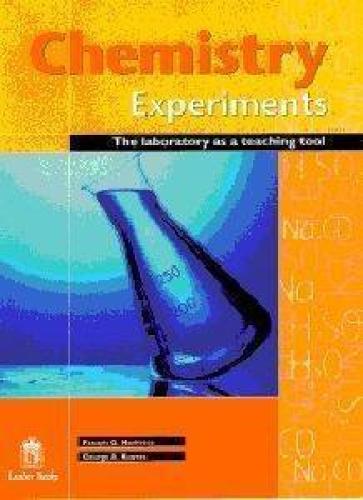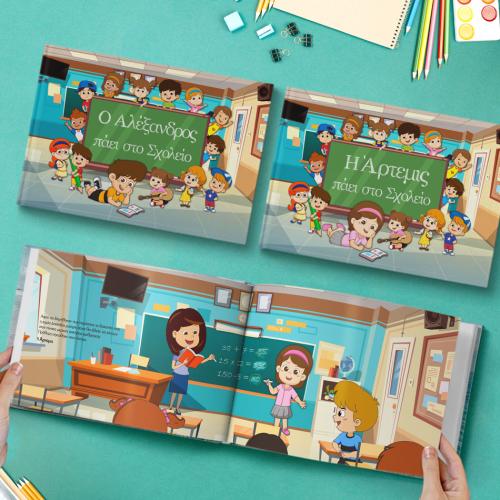THIS TITLE IS NO LONGER AVAILABLE The title of this book reflects the view of the authors on the importance of laboratory work in the teaching of Chemistry. The use of the laboratory as a teaching tool has been succesfully employed by the auhors over a long period of time and their experience from this approach has been condensed in the current laboratory manual. In this book we have included instructions for 41 Chemistry experiments, which were written specifically for the teaching of Chemistry (SSC and AHL) within the International Baccalaureate (IB). These experiments have been tried for a long period of time and address all internal assessment criteria, including planning. In every practical detailed instructions lead the student, step by step, to the achievement of the aims of the experiment. Amounts of reagents, masses of substances, concentrations of solutions and experimental conditions are explicitly mentioned, thus assisting considerably the work of the teacher. After two introductory practicals, the students investigate types of reactions, emission spectroscopy with the help of flame tests and determine the empirical formula of an unknown compound. Three experiments on gases and the determination of the melting point of a solid connect theoretical work on states of matter and gas laws to practical work. The preparation of a compound, in which centrifugation and filtration are used, helps discuss stoichiometry, n = CV, reagents in excess and the yield of a process. Recrystallization, chromatography and short investigations of physical properties of substances lead naturally to four thermochemistry practicals, in which heats of solution and combustion, Hess' law and heat capacities are introduced. Three experiments on chemical kinetics and a set of short investigations on catalysis are then suggested. Le Chatelier's principle is central to practical work on equilibria. The effect of T, P and C on the position of an equilibrium is investigated using reactions in which colour changes take place. The use of the pH meter and the conductivity meter is then introduced, with the help of reasonably priced electronic instruments. Several experiments involving acidic and basic solutions follow, in which the student determines the dissociation constant Ka for a weak acid, performs a titration and investigates properties of indicators and of acidic, basic and buffer solutions. Five experiments on redox and electrochemistry are followed by four organic chemistry experiments, in which the student investigates types of organic reactions, prepares a compound by performing reflux and distillation, purifies a compound, prepares a polymer and a soap and determines the equilibrium constant of an organic reaction. Finally, an appendix on the theory of measurement discusses significant figures to the depth required by the IB Chemistry course.
- 🔥 Εκατομμύρια προϊόντα
- Βρείτε εύκολα Προσφορές και Καταστήματα
- Markethub - Το Ελληνικό Marketplace

 AUTO / MOTO
AUTO / MOTO GADGET / ΔΩΡΑ
GADGET / ΔΩΡΑ ΕΛΕΥΘΕΡΟΣ ΧΡΟΝΟΣ
ΕΛΕΥΘΕΡΟΣ ΧΡΟΝΟΣ ΓΑΜΟΣ / ΒΑΠΤΙΣΗ
ΓΑΜΟΣ / ΒΑΠΤΙΣΗ ΓΡΑΦΕΙΟ / ΣΧΟΛΙΚΑ
ΓΡΑΦΕΙΟ / ΣΧΟΛΙΚΑ ΣΠΙΤΙ / ΚΗΠΟΣ
ΣΠΙΤΙ / ΚΗΠΟΣ ΕΠΑΓΓΕΛΜΑΤΙΚΟΣ ΕΞΟΠΛΙΣΜΟΣ
ΕΠΑΓΓΕΛΜΑΤΙΚΟΣ ΕΞΟΠΛΙΣΜΟΣ ΚΑΤΟΙΚΙΔΙΑ
ΚΑΤΟΙΚΙΔΙΑ ΜΟΔΑ / ΑΞΕΣΟΥΑΡ
ΜΟΔΑ / ΑΞΕΣΟΥΑΡ ΟΜΟΡΦΙΑ / ΥΓΕΙΑ
ΟΜΟΡΦΙΑ / ΥΓΕΙΑ ΠΑΙΔΙΚΑ / ΕΙΔΗ ΒΕΒΕ
ΠΑΙΔΙΚΑ / ΕΙΔΗ ΒΕΒΕ ΤΕΧΝΟΛΟΓΙΑ
ΤΕΧΝΟΛΟΓΙΑ ΤΡΟΦΙΜΑ / ΠΟΤΑ
ΤΡΟΦΙΜΑ / ΠΟΤΑ








